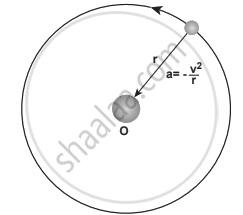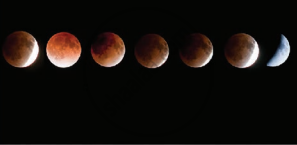Advertisements
Advertisements
प्रश्न
Explain how Newton arrived at his law of gravitation from Kepler’s third law.
उत्तर
Newton considered the orbits of the planets as circular. For a circular orbit of radius r, the centripetal acceleration towards the center is
a = `-"v"^2/"r"` ........(1)

Point mass orbiting in a circular orbit
Here v is the velocity and r, the distance of the planet from the center of the orbit.
The velocity in terms of known quantities r and T is
v = `(2π"r")/"T"` .......(2)
Here T is the time period of the revolution of the planet. Substituting this value of ‘v’ in equation (1) we get,
a = `-((2π"r")/"T")^2/"r"`
= `-(4π^2"r")/"T"^2` ........(3)
Substituting the value of ‘a’ from (3) in Newton’s second law, F = ma where ‘m’ is the mass of the planet.
F = `-(4π^2"mr")/"T"^2` .......(4)
From Kepler’s third law,
`"r"^3/"T"^2` = k (constant) ......(5)
`"r"/"T"^2 = "k"/"r"^2` .....(6)
By using equation (6) in the force expression, we can arrive at the law of gravitation.
F = `-(4π^2"mk")/"r"^2` .......(7)
Here negative sign implies that the force is attractive and it acts towards the center. He equated the constant 4π2k to GM which turned out to be the law of gravitation.
F = `-"GMm"/"r"^2`
APPEARS IN
संबंधित प्रश्न
Explain how geocentric theory is replaced by heliocentric theory using the idea of retrograde motion of planets.
Explain in detail the Eratosthenes method of finding the radius of Earth.
Describe the measurement of Earth’s shadow (umbra) radius during the total lunar eclipse
The following photographs are taken from the recent lunar eclipse which occurred on January 31, 2018. Is it possible to prove that Earth is a sphere from these photographs?

A student was asked a question ‘why are there summer and winter for us? He replied as ‘since Earth is orbiting in an elliptical orbit, when the Earth is very far away from the Sun (aphelion) there will be winter, when the Earth is nearer to the Sun (perihelion) there will be winter’. Is this answer correct? If not, what is the correct explanation for the occurrence of summer and winter?
The Moon Io orbits Jupiter once in 1.769 days. The orbital radius of the Moon Io is 421700 km. Calculate the mass of Jupiter?
